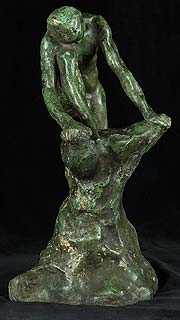
The literary source of this figure came from Ovid’s
Metamorphoses, like of so many of Rodin’s mythological works. The
Cyclops Polyphemus fell in love with the nymph Galatea, who in turn was
loved by Acis, a Sicilian shepherd. One day Polyphemus took his musical
instrument compositing of numerous pipes and made the hills and the waters
echo the music of his love song. Galatea lay hid under a rock by the side
of her beloved Acis, and listened to Polyphemus's praises of her beauty,
mingled with passionate reproaches of her coldness and cruelty. When
Polyphemus had finished, he wandered into the woods and discovered Acis
and  Galatea
hiding beneath the rocks together. Furious and jealous, he hurled a large
stone at them. Galatea could escape by a jump into the sea, but Acis,
fleeting, was pursued by Polyphemus and overwhelmed. Galatea
hiding beneath the rocks together. Furious and jealous, he hurled a large
stone at them. Galatea could escape by a jump into the sea, but Acis,
fleeting, was pursued by Polyphemus and overwhelmed.
In the composition of Rodin the mythological scenery is
more generalized: the one-eyed cyclop is turned into a two-eyed man. The
group is dominated by the diagonal stretched body of the giant, who ,
contrary to all imagination of gigantic and muscular, appears elongated
and rather thin.
Despite Rodin's original intention the composition was
never inserted in 'The Gates'. Perhaps the whole group was too complicated
and too particular in its iconography, Tancock suggests. The figure of
Polyphemus, however, does appear in 'The Gates' above the center of the
right panel. A terra-cotta version of the isolated figure is in the Musée
Dr. Faure in Aix-les-Bains.
|